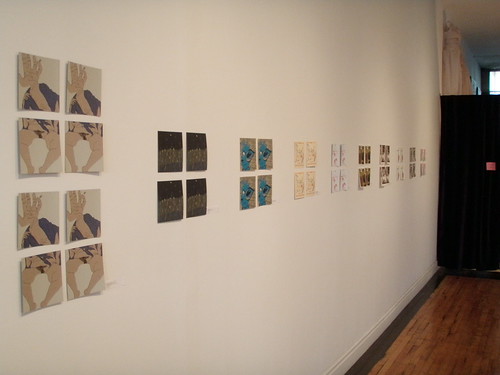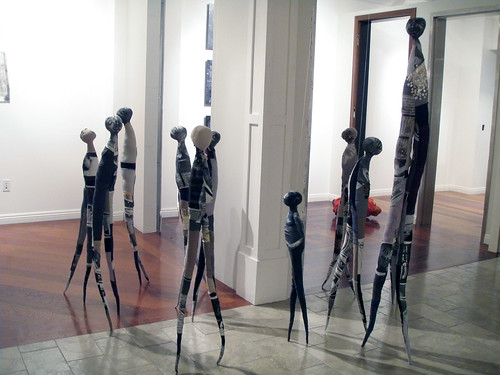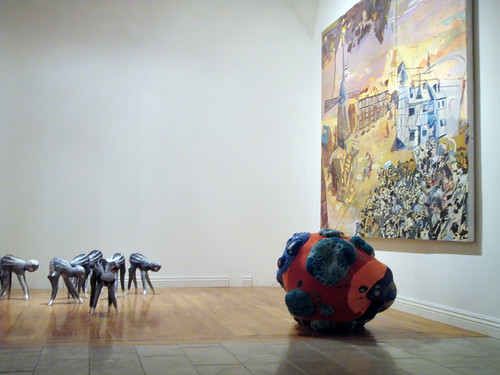
My drive to the George Billis Gallery in Culver City, California last Friday took me on a nostalgic trek up La Cienega Blvd. to West Los Angeles, an old stomping ground of mine in my 20’s and 30’s. The journey on La Cienega from the 405 freeway to the gallery was a typical LA stop and go exercise, which on the plus side, gave me time to reflect on landmarks that conjured up visions of my wilder years. Once at my destination, I found the front door open inviting visitors into a nice but somewhat casual space. Working my way through a display of contemporary paintings and guests, I found myself in a small back room of the gallery where I encountered 3 rather large woodblock prints by the Israeli artist Orit Hofshi. The giant brown monochrome prints filled the space and gave the viewer an eery sense of being transported to a stark alien landscape. The artist’s use of bold tool marks, dark brown color and images of vast barren landscapes gave the works an aggressive masculine characteristic. The prints were displayed in typical print shop fashion, unframed or matted hung simply by small binder clips along the top edge of the prints. The white walls were void of an artist’s statement or cards with the artist’s name and title of the works.
On a quest for detailed information about the works and the artist, I waited patiently until the young gentleman behind the counter, in the center of the galley, was finished talking to a couple of lady patrons. After the ladies walked away, I approached the counter and asked, “could you tell me the titles of the woodcuts and the artist’s name. Also, do you have any additional information about him”? The young man, who looked like an artist himself - that is what my idea a 2010 artist is suppose to look like, quickly replied, “ Ms. Hofshi is an Israeli artist and the works are titled Flash, the print with the figure, Venue, the horizontal landscape and Serrate, the vertical landscape”. I countered with an apology saying, “I’m sorry but I thought because of the heavy aggressive nature of the images that the artist was a male”. To that the young man, who’s name is Jose Lopez the gallery’s assistant director, said, “yes a lot of people think the artist is a man, however she is a soft spoken articulate lady who has told me that she takes out her aggression in her works”. He said, “Hofshi confided in me that as a result of the holocaust, wars and the terrorist attacks her people have endured she has no living family or relatives. It is these feelings of angst that she is conveying in her bold expansive desolated landscapes.” Jose went on to tell me that Hofshi’s prints are made from multiple planks of pine that she butts up together and then inks and prints all of them at one time by hand using the back of a spoon as a barren. He said “the planks do not lay flat, so running them through a press is impossible”.
After my conversation with Jose, I went back to the room with Hofshi’s prints for a closer look. All three prints depicted a similar barren landscape of a dried out river bed winding its way through a rocky undulating canyon. But of the three prints the one titled “Flash” which incorporates a figure in the upper right with arms raised towards the heavens and back to the wind that captivated me. The figure, neither male or female, is staring out towards the dry riverbed as if calling on God to save mankind from itself. In this print unlike the others, Hofshi incorporates large sections of inked but uncarved wood on the top and bottom of the print that immediately call attention to the medium. It’s almost as if the image was etched into the side of an old barn by a divine force. The grain of the wood and its imperfections enhance the aesthetic quality of the work. Having heard the story of Hofshi’s family, one can only imagine the emptiness she must feel that is expressed in this piece.
In closing, this was a most valuable experience to break from work for a few hours to visit the George Billis Gallery and see these three works by Orit Hofshi. My only regret was that there were not more of her works to view. Her aggressive style and subject matter has a broad appeal to a great number of art lovers and especially to us who have a passion for printmaking. When I arrived back at my office later that afternoon I Googled the artist and found a great interview with the artist from the Philagrafika in Pennsylvania dated March 9th. (http://philagrafika.blogspot.com/2009/03/interview-orit-hofshi.html) For anyone interested in learning more about Orit Hofshi and her work the interview is a great opportunity to hear the artist’s own insight into her life and work.

 Sunday April 10, 2010 I went to George Billis Gallery on La Ceinega in Culver City to view the prints of noted Israeli Printmaker Orit Hofshi exhibtion: Between the Lines. It's so much better to view these images in person, because of their large scale. Two images used eight plates and the third image used four. They were all printed with a brown ink with tanish color paper. The two images across from each other “Serrate“ and “Venue“ were made in 2002, while “Flash” was made in 2004.
Sunday April 10, 2010 I went to George Billis Gallery on La Ceinega in Culver City to view the prints of noted Israeli Printmaker Orit Hofshi exhibtion: Between the Lines. It's so much better to view these images in person, because of their large scale. Two images used eight plates and the third image used four. They were all printed with a brown ink with tanish color paper. The two images across from each other “Serrate“ and “Venue“ were made in 2002, while “Flash” was made in 2004.











